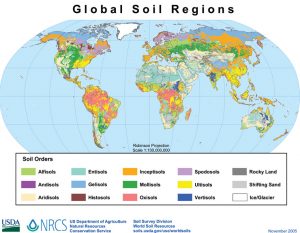2.1 Global Scale
At the global scale, clear spatial patterns exist in the distribution of soil types as represented by the soil orders, the highest level of the USDA soil taxonomy system (Fig. 2‑1). The USDA soil taxonomy system (link) is one of several widely-used soil classification systems worldwide (link). The patterns you see in Fig. 2‑1 are strongly influenced by the global patterns of climate variables such as temperature and precipitation. In the frigid regions above 60°N latitude, we find large expanses of Gelisols, which are soils with a subsurface layer that remains frozen throughout the year, while the hot and humid equatorial regions of South America and Africa are dominated by Oxisols, the most highly weathered soils on Earth. The east to west gradient of decreasing precipitation across the southern United States is clearly reflected in the progression of soil orders from Ultisols in the southeast to Mollisols in the south central region to Aridisols in the southwest.
These soil order patterns spanning thousands of kilometers also indicate large scale patterns in soil physical properties that influence countless processes in the Earth’s coupled human and natural systems. In fact, these global distributions of soil physical properties are not only influenced by climate, but they also influence climate.

For example, one significant uncertainty in projections of future climate change is the fate of the large amount of organic carbon stored in the world’s permafrost soils [1]. As global temperatures continue to rise, these soils are thawing and the organic carbon is decomposing, resulting in increased carbon dioxide and methane emissions to the atmosphere. If these emissions are not offset by increases in carbon dioxide uptake due to increased plant growth in the warmer climate, then these greenhouse gases released from thawing soils may create a feedback loop that accelerates climate change. Thus, there is a growing need to better understand gas emissions and plant growth in these thawing soils, both of which depend strongly on the soil temperature and moisture dynamics, which are themselves influenced by the soil physical properties.

